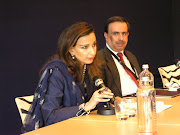Think tanks in India are in the midst of a controversy. They are accused of being agents of foreign powers, of being personal fiefdoms of a few individuals and of being run like Masonic cults. Is there any real truth in these charges? If so, should the government take action against these think tanks? What place, if any, should think tanks have in pluralistic democracy?
As in most vibrant democracies, India has a huge number of non-governmental organizations (NGOs) in almost every sector. For a country that has aspirations of becoming a great power, however, there are just a few organizations that could be loosely termed think tanks. While the number of NGOs all over the country would run into hundreds of thousands, the number of think tanks would probably not touch even 100. This is in keeping with the definition of a think tank, in the Oxford dictionary, as a "body of experts providing advice and ideas on specific national and commercial problems."
Think tanks in India fall into four categories. First are those organizations that are autonomous in their functioning, but are dependent almost completely on government funding for their survival. Then there are the thinks tanks that are identified with specific political parties. Unlike in Germany where foundations sponsored by political parties are extremely influential and well funded, think tanks closely associated with Indian political parties, with the odd exception, are rarely high profile and their influence is limited to the party they are linked with. In this sense, they resemble a caucus or a pressure group within the political party.
There are also the "umbrella" organizations that focus on the whole gamut of policy issues, ranging from economics to ecology, science and technology to security. There are not many bodies like this, and the few that exist are also now seeking to carve out a particular niche. Finally, there are think tanks devoted to specific issues. These usually work on economic problems or themes related to governance, security or defense.
Economic think tanks usually work on macro issues. These are probably the most influential of think tanks. They are generally supportive of liberalization and view globalization as a challenge and opportunity for the country. There are of course a few that are still supportive of 'swadeshi' and autarkic economic policies, but these are closely connected with tendencies within political parties. The former are often accused of supporting a World Bank-IMF driven policy agenda.
Think tanks working on governance usually focus on Center-State relations, the possibilities of decentralization and devolution including the merits of the 'Panchayati Raj' system, and the problems of specific regions such as the North East or Kashmir. In addition, some may also examine the problems posed by corruption, criminalization of politics, human rights abuses and the need for constitutional and electoral reform. Again, these think tanks are charged with strengthening centrifugal and separatist tendencies.
Finally, we have think tanks working on security issues, and, these are seen as being the most controversial. Many of them were set up during the 1990s, though there are a few that have been working on foreign policy issues since the 1960s. Researchers from within these bodies have often taken positions that go against the country's existing policy on the nuclear issue, relations with Pakistan or China. Not surprisingly, they are often openly accused of being American agents.
Many think tanks do take positions that go against government policy and the existing order. Does that make them anti-national? In a democracy, are individuals and organizations expected to conform to the government line? Isn't debate essential to true democratic functioning?
Consider first how these bodies are set up. A think tank cannot be started without registering as an NGO with the Registrar of Societies, who has to establish whether it will promote public interest. The think tank has to have properly codified byelaws that have to be consistent with democratic norms of functioning. There needs to be a governing board of at least seven members, whose interests are related to the aims of the think tank. All accounts have to verified and certified as correct by a registered chartered accountant at the end of every year.
Many independent think tanks also depend on the government for projects, or on government-sponsored funding agencies like the Indian Council for Social Science Research. They cannot get foreign funding unless the project and the funding is cleared by the Department of Economic Affairs, which one presumes also gets clearance from the Intelligence Bureau and the Ministry of External Affairs. No seminar can be organized, in which there is foreign participation, unless prior permission is obtained from the Ministry of External Affairs, the Home Ministry and the ministry directly concerned with the subject being discussed.
Admittedly, a sophisticated operation run by a foreign intelligence agency can still circumvent the lengthy bureaucratic procedure, and there may well be think tanks run by agents of foreign powers. But to what end? It would mostly mean a waste of huge resources, even if funded by intelligence agencies. Indeed, a systematic survey reveals that Indian think tanks have rarely changed policy on any issue of substance. Security think tanks, especially if run by analysts who are seen as dissenters, are rarely taken seriously even by officialdom.
An easier way for foreign intelligence agencies is to secure the services of those directly working within the government. This will buy them both information not publicly available and influence, neither of which any think tank can provide them. In other words, think tanks are a red herring; the real enemy is probably somewhere no one suspects it to be.
(Source: indiainfo.com)
















